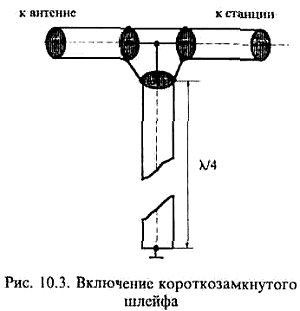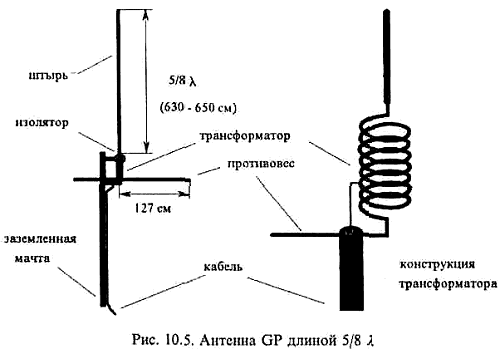
|
|
ENCYCLOPEDIA OF RADIO ELECTRONICS AND ELECTRICAL ENGINEERING Do-it-yourself GP 1/4, 1/2, 5/8 antennas. Encyclopedia of radio electronics and electrical engineering
Encyclopedia of radio electronics and electrical engineering / VHF antennas In the CB band, antennas with vertical polarization are most widely used. This is due to the fact that CB radios are widely used to communicate with moving objects, and it is very difficult to place an effective horizontal polarization antenna on a car. For the same reason, antennas with a circular radiation pattern in the horizontal plane are chosen as the base antennas, which work equally well in any direction. GP with length l/4 The most widely used in this group are antennas of the "Ground Plane" type, or "GP" for short, shown in Fig. 10.2. The antenna has a whip design, convenient for placement both on the roof of a building and on a car. It is simple and, at the same time, quite effective. Pin length (l/4) for operation in the 27 MHz band depends on the diameter of the tubes and is indicated in Table 1 Table 1. Length of GP antenna elements
For normal operation of the antenna, it is equipped with three counterweights, which can be made from a tube or antenna cord. The length of the counterweights is chosen equal to, or 2,5% more than 2/4l. For the CB range, you can take it equal to 275 cm. The input impedance of the antenna depends on the angle between the counterweights and the mast: the smaller this angle (the counterweights are pressed to the mast), the greater the resistance. To obtain an input resistance of 50 ohms, the angle is chosen to be 30-45 degrees. The radiation pattern in the vertical plane has a maximum at an angle of 30 degrees to the horizon. Antenna gain is approximately equal to that of a vertical half-wave dipole. The best performance is achieved with a mast height of about 6 m. This antenna has the widest bandwidth of all GP options. If, after installation, the minimum SWR of the antenna is slightly higher or lower than the frequency of 20 channel of grid C, the length of the pin must be increased or decreased accordingly. After tuning the antenna to resonance, the minimum SWR at the middle frequency is achieved by changing the angle of installation of the counterweights.
The disadvantage of this design is the lack of connection of the pin with the mast, which requires additional measures for lightning protection and protection from static electricity. The simplest way to protect is to use a short-circuited loop of a cable with a length of l/4 connected to the feeder with a tee. The loop provides connection of the central core of the feeder with a grounded DC braid and does not affect the antenna matching. The loop connection diagram is shown in fig. 3 The length of the loop is calculated taking into account the shortening factor of the cable used and is about 2 m. GP with length l/2
On fig. 10.4 shows the design of a half-wave antenna GP with a length l/2. Compared to the antenna described above, it has twice the length of the pin, which imposes increased requirements on ensuring the wind strength of the structure. The antenna does not need counterweights, the role of which is performed by the mast, and its directivity pattern in the vertical plane is more strongly pressed to the horizon, which improves the conditions for radio exchange with remote correspondents. Since the antenna has a high input impedance, the cable is connected to it through a matching high-frequency transformer. The base of the pin is connected to the grounded mast through a matching transformer, which automatically solves the problems of lightning protection and static. Antenna gain compared to a half-wave dipole is about 4 dB. Typical data of the matching transformer: Frame diameter - 30mm
GP with 5/8 lengthl
The most effective for long-distance communications is GP length 5/8l. Its design is shown in Fig. 10.5. It is somewhat longer than a half-wave antenna, and the feeder cable is connected to a matching inductance located at the base of the vibrator. This type of antenna requires the use of at least three counterweights with a length of (0,1-0,2)llocated in the horizontal plane. Antennas of this type are narrower than half-wave antennas, and therefore they require more careful tuning. Tuning at the middle frequency is provided both by changing the length of the pin and by adjusting the value of the matching inductance. The desired input impedance is achieved by selecting the point of connection of the cable to the matching coil. The gain of this antenna is 5-6 dB, the maximum of the radiation pattern is located at an angle of 15 degrees to the horizon. The pin of this design is also grounded to the mast through a matching coil. Approximate data of the matching coil for the characteristic impedance of a 50 Ohm cable: frame diameter - 18 mm,
Installing an antenna on a roof can greatly affect its performance. The general recommendations are the following:
The efficiency of the antenna for transmission is higher, the lower the ohmic losses in its elements. Therefore, copper tubes are the best material for antenna elements, however, the use of aluminum (duralumin) tubes can be considered an acceptable compromise (due to the high specific gravity and low strength of copper).
If it is necessary to expand the frequency band, the diameter of the tubes is increased, or tubes with a ribbed outer surface are used. Since the current flowing through the antenna rod decreases towards its upper end, the diameter of the upper part of the rod can be reduced without degrading its parameters. One of the simplest means of expanding the bandwidth of long whip antennas is the use of a sleeve with four whiskers about 100 mm long and 4-5 mm in diameter, fixed at the top of the whip (Fig. 10.6). In this case, the resonant frequency of the antenna decreases and the length of the pin will have to be slightly reduced. When the antenna is transmitting, rather large currents flow through it, so it is necessary to ensure a very good connection of all elements to each other and take care of their protection against corrosion. Currently, commercially available CB antennas are factory-made (Fig. 10.7), both domestic and imported, light, elegantly made. As evidenced by the experience of their operation, in the connections of elements, which are carried out by self-tapping screws, electrical contact is quickly lost under the influence of wind. More reliable is the design of pins with clamps. Almost all types of industrial antennas require additional sealing to prevent water from entering the tubes, matching transformers, coils and cable termination, which leads to irreversible consequences.
If on the roof of your house there is a sufficiently high elevator booth, a television antenna or an outbuilding with a height of more than 5 meters, then the GP antenna can be installed using a nylon stretch cable (Fig. 10.8) without a mast. In addition to the kapron cord and the RK-50 cable, 4 more insulators of any type will be required. The end of the cable 2,7 m long is released from the outer insulation and braid, the braid is untwisted and twisted into 4 approximately identical "pigtails". They are joined by counterweights. Counterweights can be made from any copper (in extreme cases, even aluminum) wire, which is screwed (or soldered) to the "pigtails". The length of the counterweights should be 2,7 m. At the ends of the counterweights, insulators are fixed, which are attached to wire or nylon guys. The end of the cable section freed from the braid is attached to the nylon cord behind the polyethylene insulator so that it does not come off with gusts of wind. Counterweights are bred to the sides evenly in a circle, braces are fixed on the roof (for example, they are tied to bricks). Try to choose the length of the guys so that there is an angle of about 45 ° between the counterweight wire and the vertical. The joints and the exit point of the cable from the braid are carefully sealed with plasticine so that water does not get under the braid.
This antenna, in its characteristics, fully corresponds to the classic GP antenna with a length l/four. It is very convenient to install such an antenna in the field between two trees, you just need to prepare a cable and counterweights with braces in advance, and even short dry sticks will fit as insulators at the ends of the counterweights (see Fig. 4), since at a frequency of 10.9 MHz it's a good insulator. Literature
Publication: cxem.net
A New Way to Control and Manipulate Optical Signals
05.05.2024 Primium Seneca keyboard
05.05.2024 The world's tallest astronomical observatory opened
04.05.2024
▪ CIA in the fight against global warming ▪ Sharp and Pioneer TVs are recognized as the most environmentally friendly ▪ Ion-conducting wood membranes
▪ section of the site Experiments in chemistry. Article selection ▪ article Look and something. Popular expression ▪ article What circumstances led mathematician Alexander Volkov to become a writer? Detailed answer ▪ article Curly mint. Legends, cultivation, methods of application ▪ article Chalk, marble, shell. Chemical experience
Home page | Library | Articles | Website map | Site Reviews www.diagram.com.ua |






 Arabic
Arabic Bengali
Bengali Chinese
Chinese English
English French
French German
German Hebrew
Hebrew Hindi
Hindi Italian
Italian Japanese
Japanese Korean
Korean Malay
Malay Polish
Polish Portuguese
Portuguese Spanish
Spanish Turkish
Turkish Ukrainian
Ukrainian Vietnamese
Vietnamese









 Leave your comment on this article:
Leave your comment on this article: